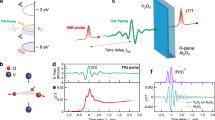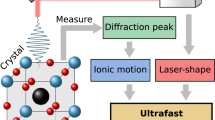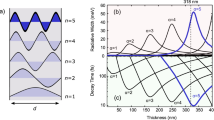Abstract
The radiation pressure of light has been widely used to cool trapped atoms or the mechanical vibrational modes of optomechanical systems. Recently, by using the electrostrictive forces of light, spontaneous Brillouin cooling and stimulated Brillouin excitation of acoustic modes of the whispering-gallery-type resonator have been demonstrated. The laser cooling of specific lattice vibrations in solids (that is, phonons) proposed by Dykman in the late 1970s, however, still remains sparsely investigated. Here, we demonstrate the first strong spontaneous Raman cooling and heating of a longitudinal optical phonon (LOP) with a 6.23 THz frequency in polar semiconductor zinc telluride nanobelts. We use the exciton to resonate and assist photoelastic Raman scattering from the LOPs caused by a strong exciton–LOP coupling. By detuning the laser pump to a lower (higher) energy-resolved sideband to make a spontaneous scattering photon resonate with an exciton at an anti-Stokes (Stokes) frequency, the dipole oscillation of the LOPs is photoelastically attenuated (enhanced) to a colder (hotter) state.
This is a preview of subscription content, access via your institution
Access options
Subscribe to this journal
Receive 12 print issues and online access
$209.00 per year
only $17.42 per issue
Buy this article
- Purchase on Springer Link
- Instant access to full article PDF
Prices may be subject to local taxes which are calculated during checkout




Similar content being viewed by others
References
Boyd, R. W. Nonlinear Optics 2nd edn, 394 (Academic Press, 2003).
Yu, P. Y. & Cardona, M. Fundamentals of Semiconductors: Physics and Materials Properties 3rd edn, 375 (Springer, 2005).
Chu, S. Nobel Lecture. The manipulation of neutral particles. Rev. Mod. Phys. 70, 685–706 (1998).
Diedrich, F., Bergquist, J. C., Itano, W. M. & Wineland, D. J. Laser cooling to the zero-point energy of motion. Phys. Rev. Lett. 62, 403–406 (1989).
Leibfried, D., Blatt, R., Monroe, C. & Wineland, D. Quantum dynamics of single trapped ions. Rev. Mod. Phys. 75, 281–324 (2003).
Wieman, C. E., Pritchard, D. E. & Wineland, D. J. Atom cooling, trapping, and quantum manipulation. Rev. Mod. Phys. 71, S253–S262 (1999).
Wineland, D. J., Itano, W. M., Bergquist, J. C. & Hulet, R. G. Laser-cooling limits and single-ion spectroscopy. Phys. Rev. A 36, 2220–2232 (1987).
Chan, J. et al. Laser cooling of a nanomechanical oscillator into its quantum ground state. Nature 478, 89–92 (2011).
Kippenberg, T. J. & Vahala, K. J. Cavity optomechanics: back-action at the mesoscale. Science 321, 1172–1176 (2008).
Aspelmeyer, M., Kippenberg, T. J. & Marquardt, F. Cavity optomechanics. Rev. Mod. Phys. 86, 1391–1452 (2014).
Teufel, J. D. et al. Sideband cooling of micromechanical motion to the quantum ground state. Nature 475, 359–363 (2011).
Verhagen, E. et al. Quantum-coherent coupling of a mechanical oscillator to an optical cavity mode. Nature 482, 63–67 (2012).
Clerk, A. A. et al. Introduction to quantum noise, measurement, and amplification. Rev. Mod. Phys. 82, 1155–1208 (2010).
Spillane, S. M., Kippenberg, T. J. & Vahala, K. J. Ultralow-threshold Raman laser using a spherical dielectric microcavity. Nature 415, 621–623 (2002).
Zhang, J., Li, D., Chen, R. & Xiong, Q. Laser cooling of a semiconductor by 40 kelvin. Nature 493, 504–508 (2013).
Epstein, R. I. et al. Observation of laser-induced fluorescent cooling of solid. Nature 377, 500–503 (1995).
Ha, S.-T., Shen, C., Zhang, J. & Xiong, Q. Laser cooling of organic–inorganic lead halide perovskites. Nature Photon. 10, 115–121 (2016).
Dykman, M. I. Relaxation of impurities in a nonresonant field and phonon amplification. Sov. J. Low Temp. Phys. 5, 89–95 (1979).
Dykman, M. I. Heating and cooling of local and quasilocal vibration by a nonresonance field. Sov. Phys. Solid State 20, 1306–1311 (1978).
Bahl, G., Tomes, M., Marquardt, F. & Carmon, T. Observation of spontaneous Brillouin cooling. Nature Phys. 8, 203–207 (2012).
Grudinin, I. S., Lee, H., Painter, O. & Vahala, K. J. Phonon laser action in a tunable two-level system. Phys. Rev. Lett. 104, 083901 (2010).
Madelung, O., Rössler, U. & Schulz, M. Landolt–Bornstein Numerical Data and Functional Relationships in Science and Technology, Group III: Condensed Matter. Semiconductors: II–VI and I–VII Compounds Vol. 41B, 159 (Springer, 1999).
Lee, K. C. et al. Entangling macroscopic diamonds at room temperature. Science 334, 1253–1256 (2011).
Haroche, S. & Kleppner, D. Cavity quantum electrodynamics. Phys. Today 42, 24–30 (1989).
Khitrova, G. et al. Vacuum Rabi splitting in semiconductors. Nature Phys. 2, 81–90 (2006).
Groblacher, S., Hammerer, K., Vanner, M. R. & Aspelmeyer, M. Observation of strong coupling between a micromechanical resonator and an optical cavity field. Nature 460, 724–727 (2009).
Zhang, Q. et al. Highly enhanced exciton recombination rate by strong electron–phonon coupling in single ZnTe nanobelt. Nano Lett. 12, 6420–6427 (2012).
Vahala, K. et al. A phonon laser. Nature Phys. 5, 682–686 (2009).
Bahl, G., Zehnpfennig, J., Tomes, M. & Carmon, T. Stimulated optomechanical excitation of surface acoustic waves in a microdevice. Nature Commun. 2, 403 (2011).
Kolkowitz, S. et al. Coherent sensing of a mechanical resonator with a single-spin qubit. Science 335, 1603–1606 (2012).
Rand, S. C. Raman laser cooling of solids. J. Lumines. 133, 10–14 (2013).
Chen, Y.-C. & Bahl, G. Raman cooling of solids through photonic density of states engineering. Optica 2, 893–899 (2015).
Utama, M. I. B. et al. The growth of ultralong ZnTe micro/nanostructures: the influence of polarity and twin direction on the morphogenesis of nanobelts and nanosheets. Cryst. Growth Des. 13, 2590–2596 (2013).
Acknowledgements
The authors acknowledge M.S. Kim for stimulating discussions. J.Z. acknowledges support from the National Natural Science Foundation of China (grant no. 11574305 and no. 51527901), China MOST (grant no. 2016YFA0301200) and the National Young 1000 Talent Plan of China. J.Z. and Q.X. acknowledge support from the LU JIAXI International team program supported by the K.C. Wong Education Foundation and the Chinese Academy of Sciences. Q.X. acknowledges major support from the Singapore National Research Foundation through a Fellowship grant (NRF-RF2009-06) and an Investigatorship Award (NRF-NRFI2015-03) and the Singapore Ministry of Education via two AcRF Tier 2 grants (MOE2011-T2-2-051 and MOE2013-T2-1-049). Q.X. also gratefully acknowledges partial support from the Asian Office of Aerospace Research and Development (FA2386-13-1-4112), an international office of the US Air Force Office of Scientific Research.
Author information
Authors and Affiliations
Contributions
J.Z. and Q.X. conceived the idea. J.Z. designed the experiments. J.Z., Q.Z. and X.W. performed the experiments and prepared the samples. J.Z., L.C.K. and Q.X. analysed the data and wrote the manuscript. All the authors read and commented on the manuscript.
Corresponding authors
Ethics declarations
Competing interests
The authors declare no competing financial interests.
Supplementary information
Supplementary information
Supplementary information (PDF 2772 kb)
Rights and permissions
About this article
Cite this article
Zhang, J., Zhang, Q., Wang, X. et al. Resolved-sideband Raman cooling of an optical phonon in semiconductor materials. Nature Photon 10, 600–605 (2016). https://doi.org/10.1038/nphoton.2016.122
Received:
Accepted:
Published:
Issue Date:
DOI: https://doi.org/10.1038/nphoton.2016.122
This article is cited by
-
Characteristics investigation of Yb3+:YAG crystals for optical refrigeration
Frontiers of Physics (2023)
-
Detecting nanoparticles by “listening”
Frontiers of Physics (2023)
-
Dual-resonance enhanced quantum light-matter interactions in deterministically coupled quantum-dot-micropillars
Light: Science & Applications (2021)
-
Detection of electron-phonon coupling in two-dimensional materials by light scattering
Nano Research (2021)
-
Growth of centimeter-scale perovskite single-crystalline thin film via surface engineering
Nano Convergence (2020)



